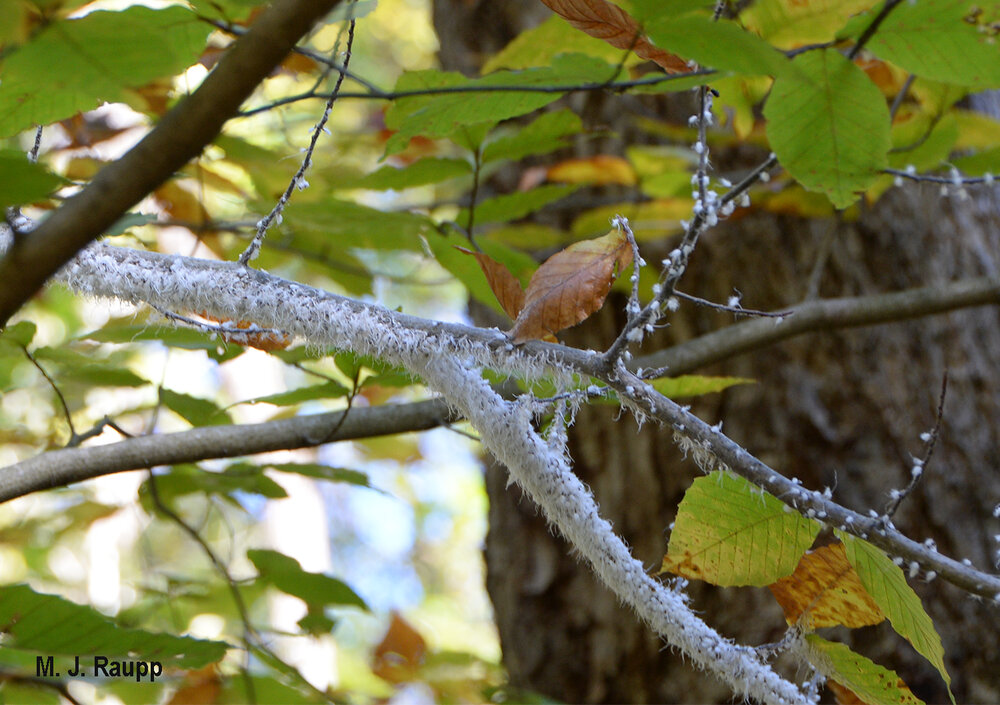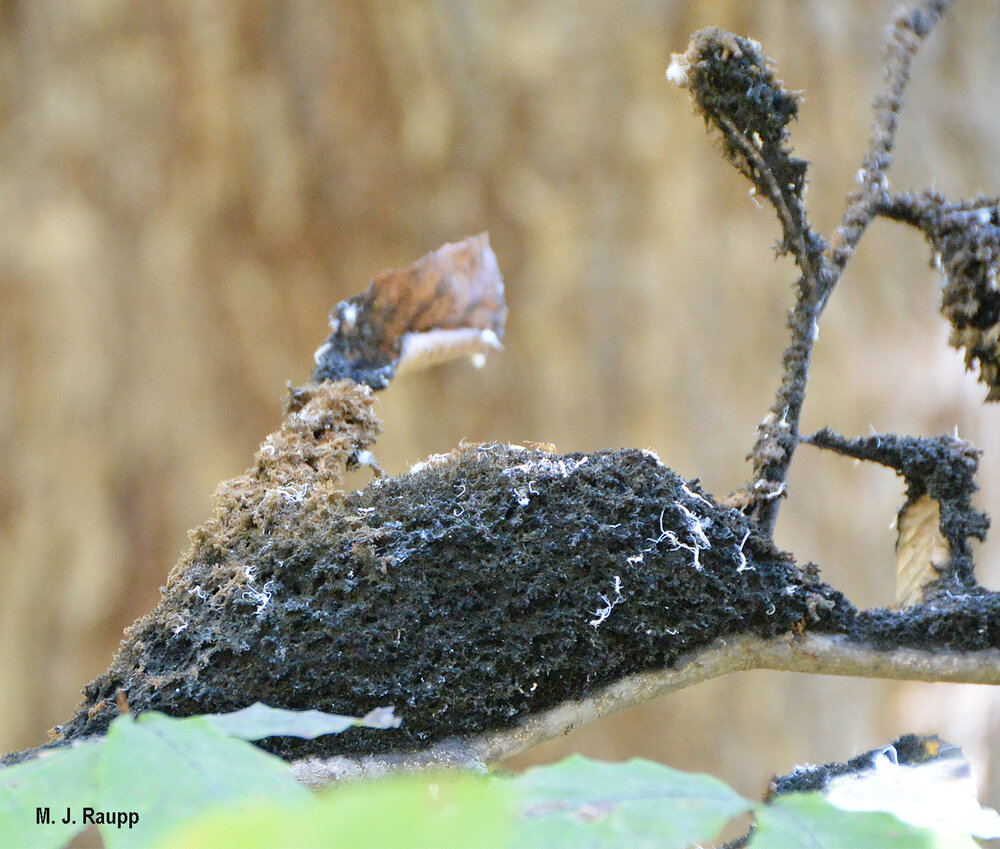Waxy ladies dance like someone’s watching: Woolly beech aphid, a.k.a. boogie-woogie aphid, Grylloprociphilus imbricator

That’s not snow you see on the branches of an American beech tree. You’re looking at white wax produced by thousands of tiny sap-sucking woolly aphids.
American beech, Fagus grandifolia, an iconic stalwart of North American deciduous forests, is prized for its massive size at maturity, dark glossy green foliage, and smooth grey bark. While wandering in a forest here in the DMV, I was startled to find an American beech with dingy black leaves and strange growths on its branches, several of which were flocked with a pulsating blanket of brilliant white wax. What mischief befell this paragon of the woods? The answer lies within the coat of white wax on the branches. A strange aphid called the woolly beech aphid, a.k.a. beech blight aphid and boogie-woogie aphid, makes American beech its home. This aphid is capable of producing incredible amounts of fluffy white wax from specialized wax glands lining its abdomen.
Life for a beech blight aphid begins with an egg that has survived winter’s chill on the bark of a beech tree. From this egg hatches a nymph that eventually develops into a wingless adult capable of producing legions of offspring. These youngsters develop into winged adults, some of which remain on the host while others depart to find a swamp cypress tree. Here they enter the soil, settle on the tree’s roots and develop by removing sap from the vascular bundles of the roots. How strange is that? Those that remain on beech trees will be parthenogenetic; a legion of Amazonian females reproducing in the absence of males. You go girls!

Honeydew excreted by legions of aphids rain down on leaves and branches below. This sugar-rich solution is the substrate for a specialist sooty mold fungus, Scorias spongiosa. This fungus cloaks leaves and branches and sometimes forms dense sponge-like mats several inches thick.
The colony will grow from just a few in spring to thousands by late autumn. Like other members of their clan, these aphids suck nutrient rich phloem sap from the vascular tissues of the beech. Excess fluid is excreted as a sugar rich product called honeydew. Vast amounts of honeydew rain down on leaves and branches below the colony. This sticky coating serves as a substrate for the growth of a unique sooty mold fungus, Scorias spongiosa, which, at first, is a thin black coating on leaves and bark. Later, as honeydew accumulates from thousands of aphids, the fungus forms a large dark sponge-like mass that may be crowned with yellow fruiting bodies of the fungus. Although sooty mold is not believed to be directly pathogenic, it may cloak leaves and reduce photosynthesis. Luxuriant honeydew and attendant sooty mold beneath infested beech trees may reduce survival of beech seedlings struggling to grow below.
While taking a photograph of the colony I disturbed a branch, which instantly sent the aphids into paroxysms, with myriad aphids waving their wax covered rear ends up in the air. The rhythmic swaying of aphid posteriors gives rise to the moniker boogie-woogie aphid. This remarkable behavior is thought to confuse predators considering an attack on members of the colony. It certainly confused me. So, when someone is watching, aphids may dance.
Brilliant white wax produced by thousands of beech woolly aphids turn small beech branches snowy white. When disturbed, aphids break into a massive swaying dance routine with abdomens and wax held high. This group reaction is thought to confuse or distract predators. Or could it be that ladies just like to dance?
Ah, but the aphid has one more defensive trick up its sleeve or, should we say, at the end of its nose. The piercing mouthparts inserted into the vascular tissue of the tree to remove sap are comprised of tiny needle-like stylets. Researchers discovered that when caterpillars were introduced to the colony, squads of hostile female soldiers attacked and stabbed the caterpillars causing them to fall from the branch. A colleague tempted the ferocity of the aphid defense when he unwittingly grasped a branch infested with aphids. He described the encounter as “…something like a cross between a burning and stinging sensation.” In the waning days of autumn, take a walk in the woods and see if you can discover a colony of boogie-woogie aphids. Maybe bust a move with them. Dance like no one’s watching.
Acknowledgements
Bug of the Week thanks Joe Boggs for providing inspiration for this episode after enduring an attack by beech woolly aphids. His Bug Bytes Blog “Attack of the Boogie-Woogie Aphids” and two fascinating studies, “Colony defense by wingpadded nymphs in Grylloprociphilus imbricator (HEMIPTERA: APHIDIDAE)” by Shigeyuki Aoki, Utako Kurosu, and Carol D. von Dohlen, and “Cascading effects of a highly specialized beech-aphid–fungus interaction on forest regeneration” by Susan C. Cook-Patton, Lauren Maynard, Nathan P. Lemoine , Jessica Shue, and John D. Parker were consulted to prepare this episode.
This post appeared first on Bug of the Week